Between 2006 and 2018, Nesta produced a series of influential research papers on a wide range of topics spanning the creative economy. The Creative PEC as an independent organisation dedicated to growing the evidence base on the creative industries emerged from this programme of work. The reports in this archive were published by Nesta, and we are now also for our readers’ convenience making them available through the Creative PEC’s website.
This archive is organised by topic when the publication was part of a series of linked reports. Otherwise, they are left as standalone entries. The topics and projects included in the archive are:
- Digital Culture
- Measuring the Economic Value of Culture
- Creative Clusters
- Creative Skills
- Innovation and R&D Policy
Digital Culture
Between 2013 and 2019, Nesta collaborated with Arts Council England in regularly surveying arts and cultural organisations based in England about their use of digital technologies across all aspects of their work, from artistic creation to business model innovation. The sample size was large, and included a panel of organisations that participated in two or more waves of survey data collection. Taken together, the surveys painted a unique and detailed picture of how England’s arts and cultural sectors were engaging with new technologies.
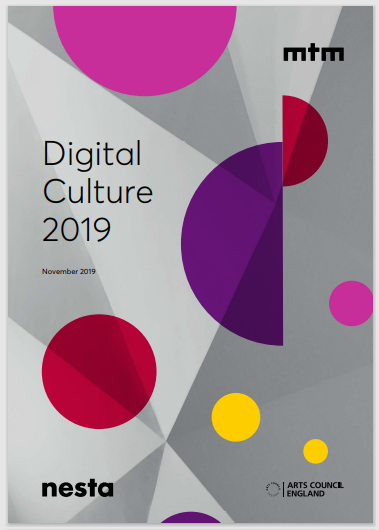
Digital Culture 2019
A study on the impact and use of technology in the arts and culture sector, from Arts Council England and Nesta.
The study provided detailed insight on digital for arts and cultural organisations to affect change within their own work, along with an in-depth analysis of the major trends to guide policymakers and sector support organisations. The report built on previously published work in 2013, 2014, 2015 and 2017.
Publication date: November 2019
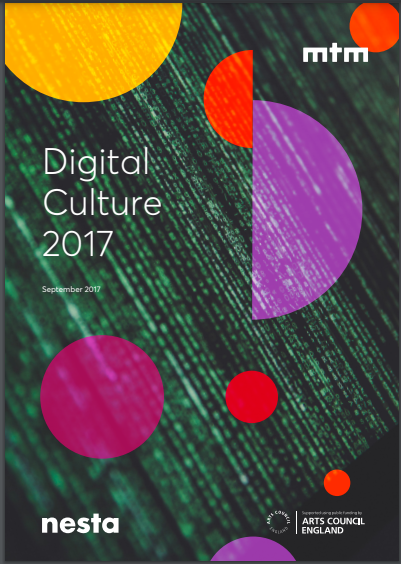
Digital Culture 2017
An Arts Council England and Nesta’s study of technology usage and impact among arts and culture organisations.
The study provides detailed insight on digital for arts and cultural organisations to affect change within their own work, along with an in-depth analysis of the major trends to guide policy makers and sector support organisations. The report builds on previously published work in 2014, 2015 and 2017.
Publication date: 26 September 2017
Measuring the Economic Value of Culture
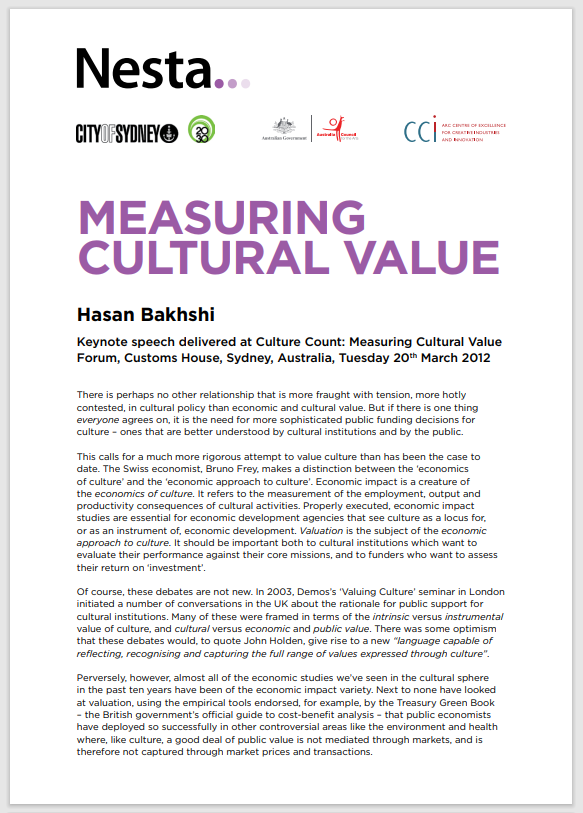
Measuring Cultural Value
This paper was based on a speech by Hasan Bakhshi, and makes the case for more rigorous valuation studies of cultural institutions.
The speech was delivered at Culture Count: Measuring Cultural Value Forum, Customs House, Sydney, Australia, on 20 March 2012. The speech focuses on why there has been such a dearth of valuation studies of cultural institutions, the dangers of the current state of affairs, and how the situation can be improved.
Publication date: March 2012
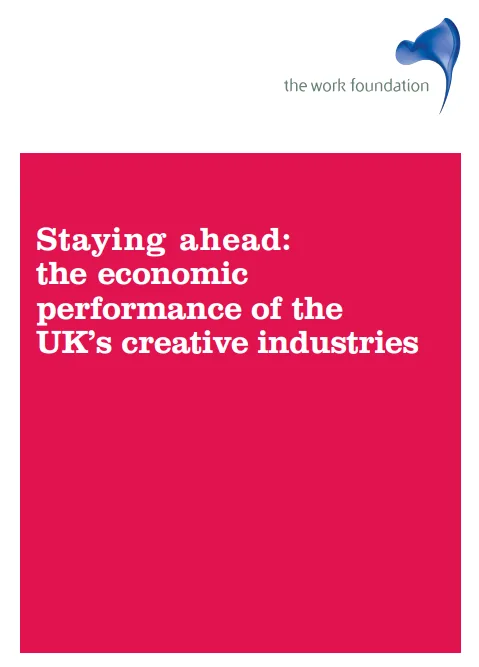
Staying ahead: the economic performance of the UK’s creative industries
This analysis by The Work Foundation and NESTA researchers puts at the heart of the UK economy scriptwriters, computer programmers, designers and musicians. It brings into focus institutions like the BBC and in doing so recognises not just their cultural influence but also their critical economic value.
Publication date: June 2007
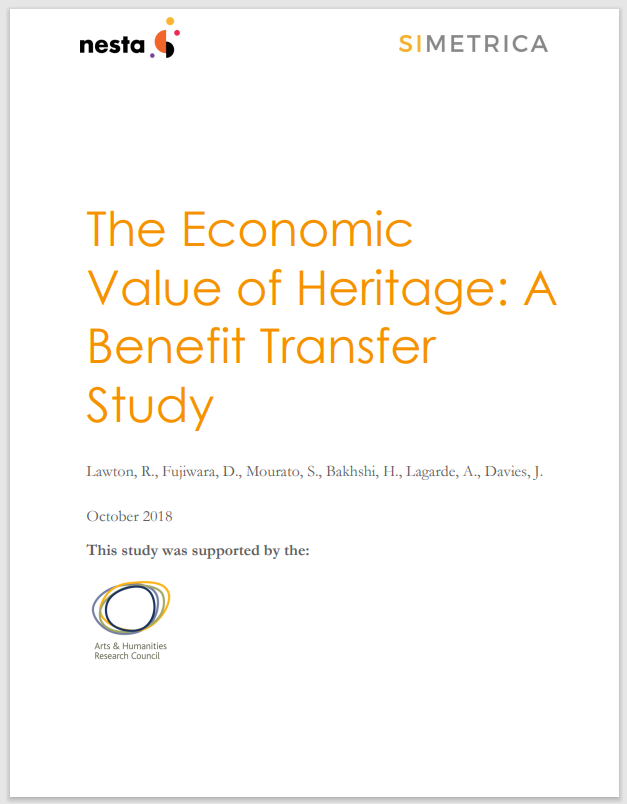
The Economic Value of Heritage
This report by Nesta and Simetrica looked at the value that users (residents and visitors) and non-users obtain from historic cities and their cathedrals.
The researchers used a technique known as contingent valuation to estimate use and non-use value and assesses the feasibility of benefits transfer. It also finds that such techniques generate credible results and that benefits transfer between comparable sites is feasible.
Publication date: 02 October 2018
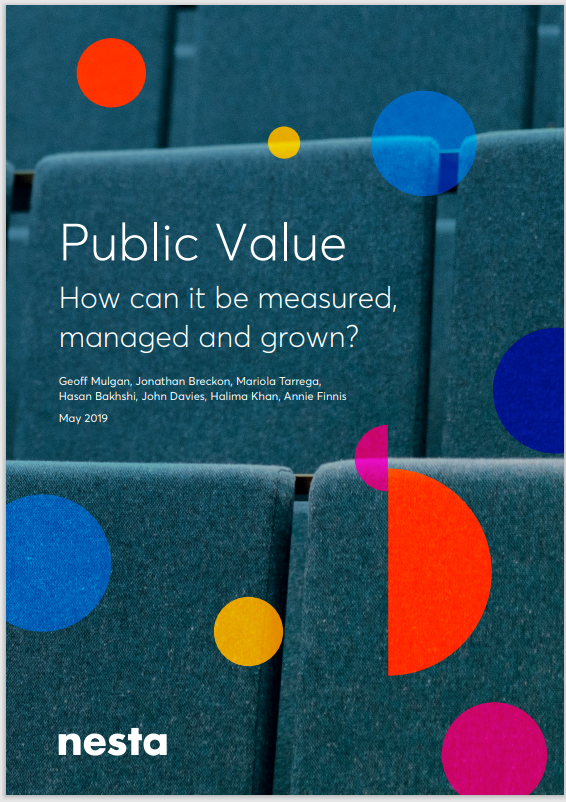
Public Value
This report brought together views from Nesta on better ways of mapping and measuring public value. It built on work Nesta has done in many fields – from health and culture to public services – to find more rounded and realistic ways of capturing the many dimensions of value created by public action.
Publication date: 31 May 2019
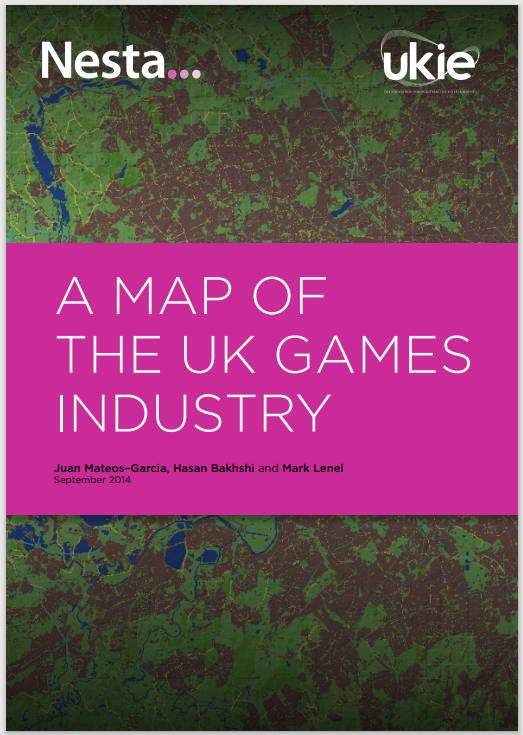
A Map of the UK Games Industry
This report took a big data approach to measure and map the UK games industry and track its evolution over time. The analysis revealed a games industry which is larger than previously thought, and one in the midst of technological and business model disruption driven by the arrival of new gaming platforms like mobile phones and tablets.
Publication date: 21 September 2014
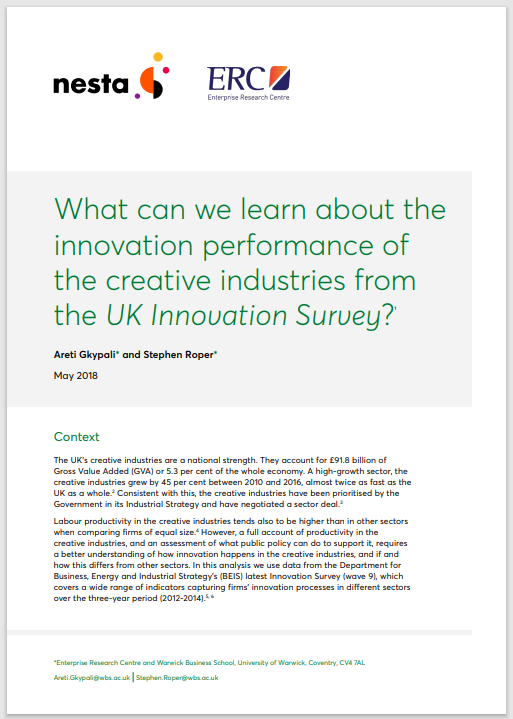
What can we learn about the innovation performance of the creative industries from the UK innovation survey?
In this paper the authors considered how the innovation processes used by creative industries businesses compare with those used in other sectors. The analysis used data from the Department for Business, Energy and Industrial Strategy’s (BEIS) latest innovation survey (wave 9), which covers a wide range of indicators capturing firms’ innovation processes in different sectors over the three-year period (2012-2014).
Publication date: May 2018
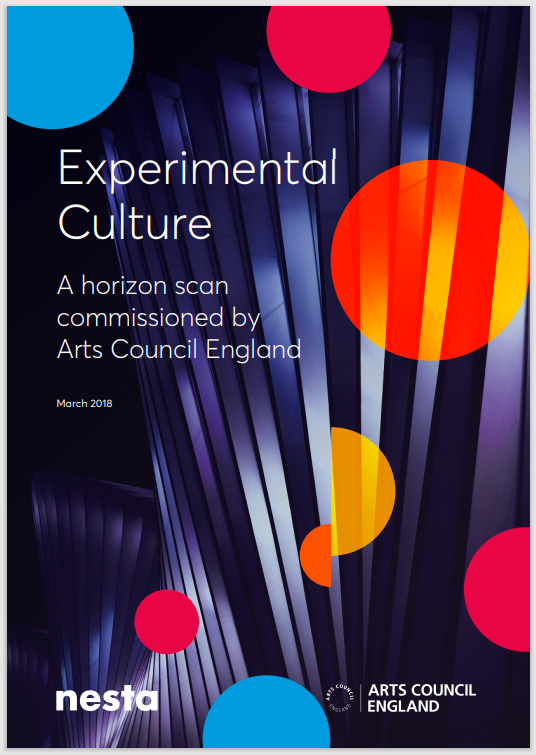
Experimental Culture: A horizon scan for the arts and culture sector
This paper was intended to serve as a prompt for Arts Council England’s consultation activity over the forthcoming months, with the intent of provoking a conversation with arts and cultural organisations about the changing context for their work
Publication date: 13 March 2018
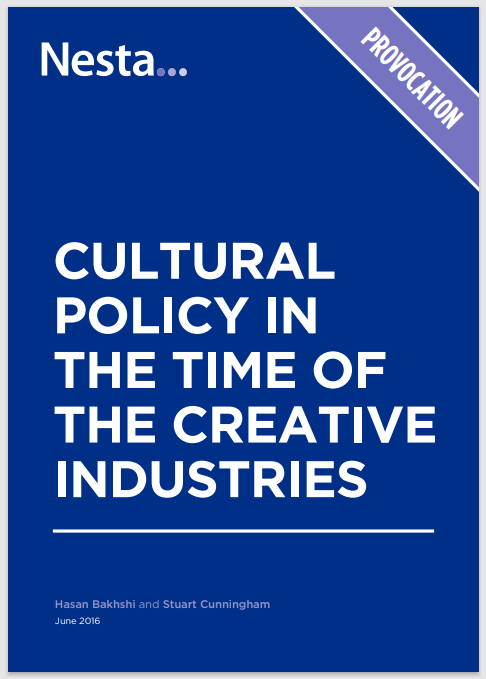
Cultural policy in the time of the creative industries
This report argued that new DCMS statistics on the cultural sector, alongside the creative industries estimates, will create an important opportunity to revisit the scope of cultural policy in the UK.
Publication date: 13 June 2016
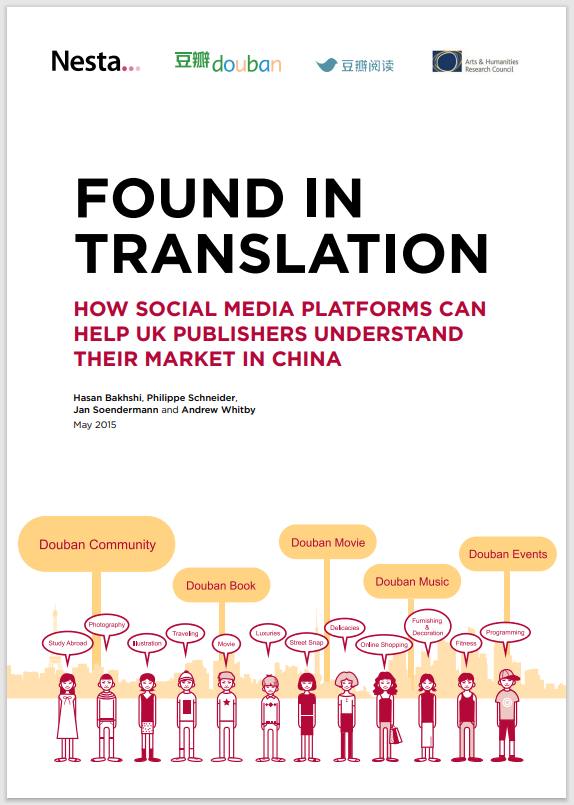
Found In Translation: How social media platforms can help UK publishers understand their market in China
In this paper, the authors explored how British publishers and writers can negotiate some of the market uncertainties of doing business in China by using social media platforms like Douban. Being at the same time a social media platform, a publisher and a retailer, Douban permits rights holders to take a data-driven approach to engaging with readers, understand their wider cultural preferences and behaviours, and identify – and exploit – their social networks.
Publication date: 27 May 2015
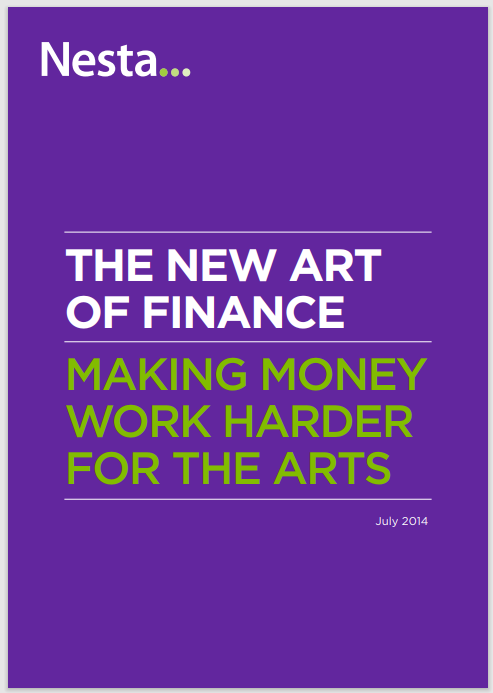
The new art of finance: making money work harder for the arts
This report showed how a portion of arts funding could be reinvented, making use of new methods that would bring in additional finance into the arts, as well as having other benefits such as making arts organisations better connected to their audiences.
Publication date: 25 July 2014
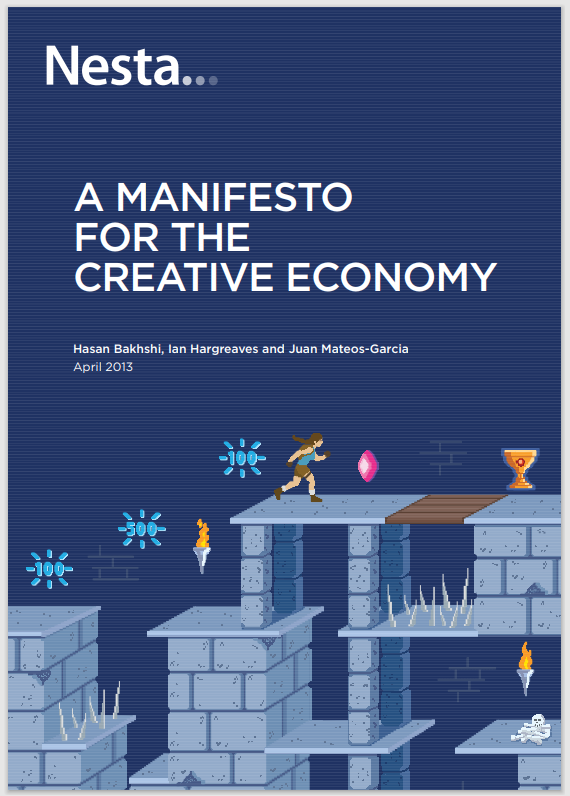
A manifesto for the creative economy
The manifesto set out a 10-point plan to bolster the creative industries, one of the UK’s fastest growing sectors.
Publication date: April 2013
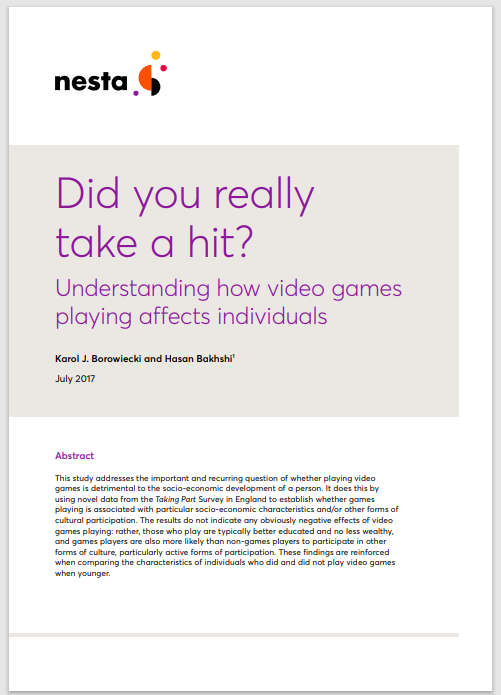
Did you really take a hit? Understanding how video games playing affects individuals
This study addressed the important and recurring question of whether playing video games is detrimental to the socio-economic development of a person.
Publication date: 21 July 2017
Creative Clusters
In a series of landmark reports, we mapped the UK’s creative clusters.
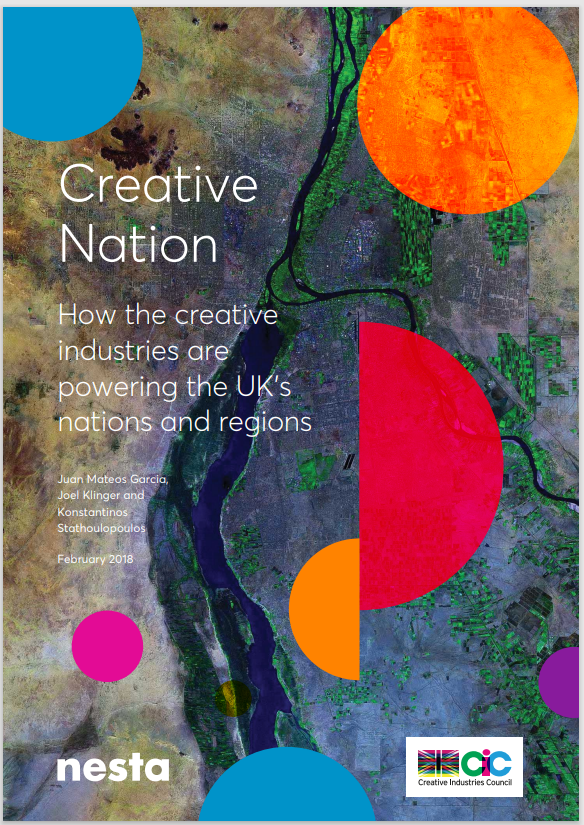
Creative Nation
This report used official, open and web data to map the creative industries in the UK, their evolution, contribution to local economic development, the strength of their support ecosystems – including research and informal networking – and their connections with each other. Ultimately, it sought to contribute to our understanding of the sector and inform the best policies to support it. It was created by Nesta in collaboration with the Creative Industries Council.
Publication date: 08 February 2018

Tech Nation 2016
This report was by Nesta and Tech City UK and produced in partnership with GrowthIntel. It was the most comprehensive analysis of the UK’s digital tech industries to date, and underlined the economic importance of digital tech businesses, which were growing 32% faster than the rest of the UK economy.
Publication date: 08 February 2016
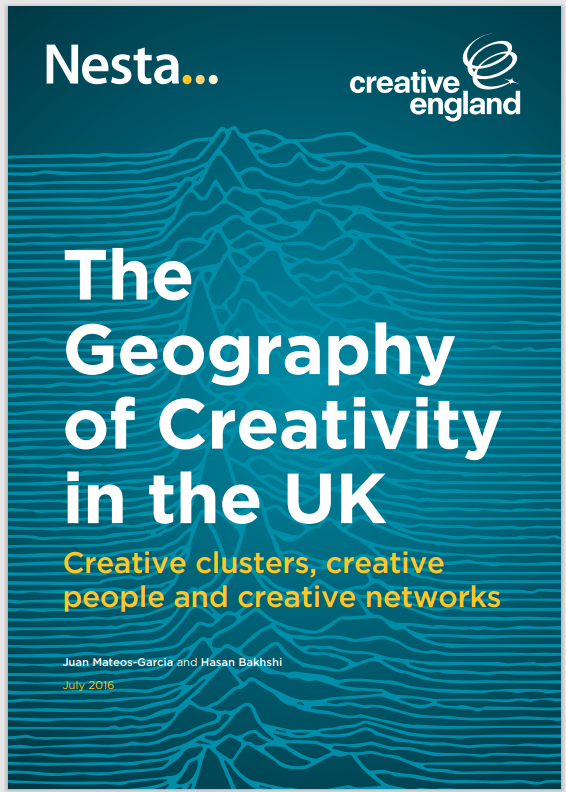
The geography of creativity in the UK
This report, in partnership with Creative England, used the latest data and official definitions to map the creative industries in the UK. The goal was to provide a data resource to demonstrate the economic significance of the creative industries across the country, and inform policies to strengthen them further.
Publication date: 22 July 2016
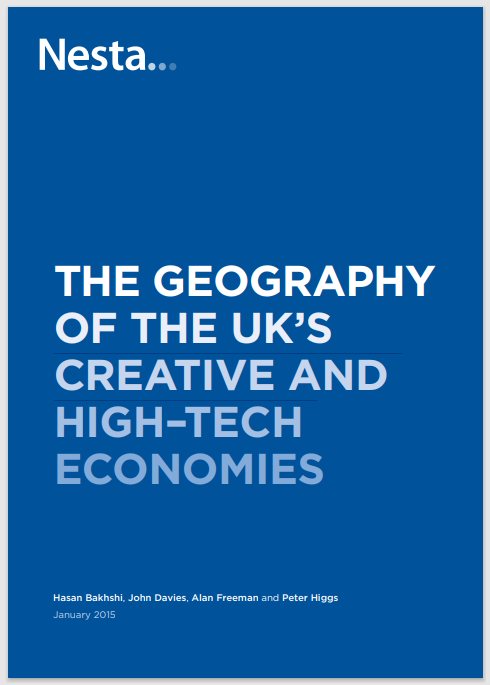
Geography of high tech and creative economies 2015
This report was the first systematic analysis of employment in the UK’s creative and high-tech economies. It analysed their size, growth and distribution across the country.
The report showed that the creative and high-tech economy are large and rapidly expanding employers. It found that the creative economy is unevenly distributed around the country, and as a result called for government policy to better support creative clusters across the UK.
Publication date: 26 January 2015
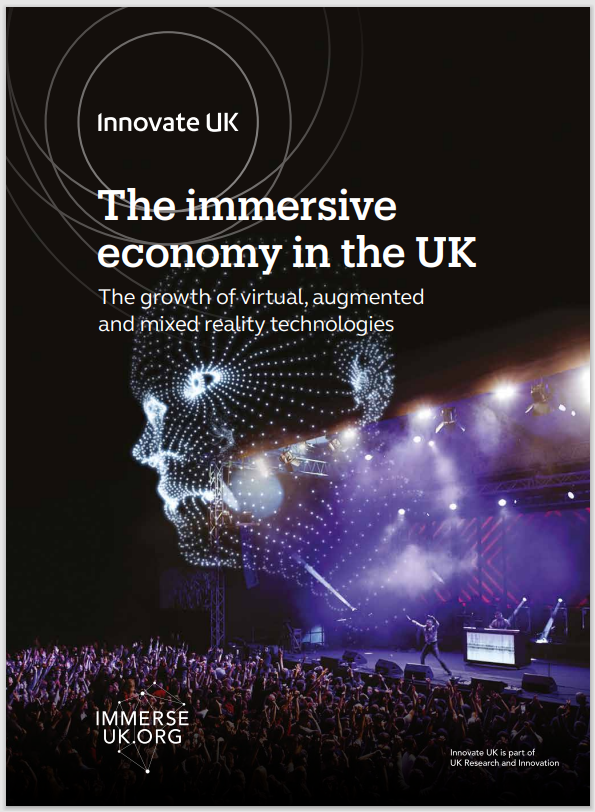
The immersive economy in the UK
This report used web data to identify and map the organisations developing and applying new technologies in the UK.
This report, commissioned by Immerse UK with funding from Innovate UK, provided hard data about the size of the sector, its performance, its geography, the drivers of success and the barriers to growth. Information was gathered and analysed by Nesta through a combination of machine learning, a business survey and in-depth interviews.
Publication date: 01 June 2018
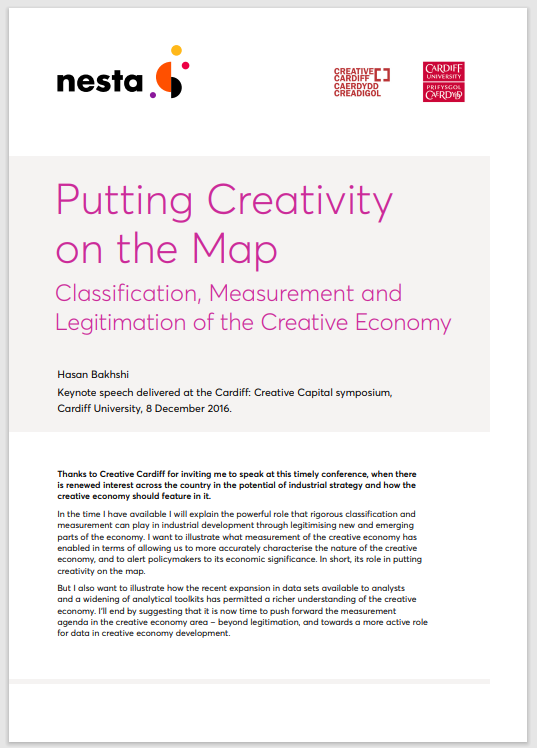
Putting Creativity on the Map.
This report reviewed how policymakers can use data to measure and support the growth of creative clusters. This report illustrated how measurement of the creative economy has given policymakers a detailed understanding of the creative economy and the nature of its economic contribution. It showed that the recent expansion in data sets and analytical toolkits permits an even richer understanding.
Publication date: 8 December 2016
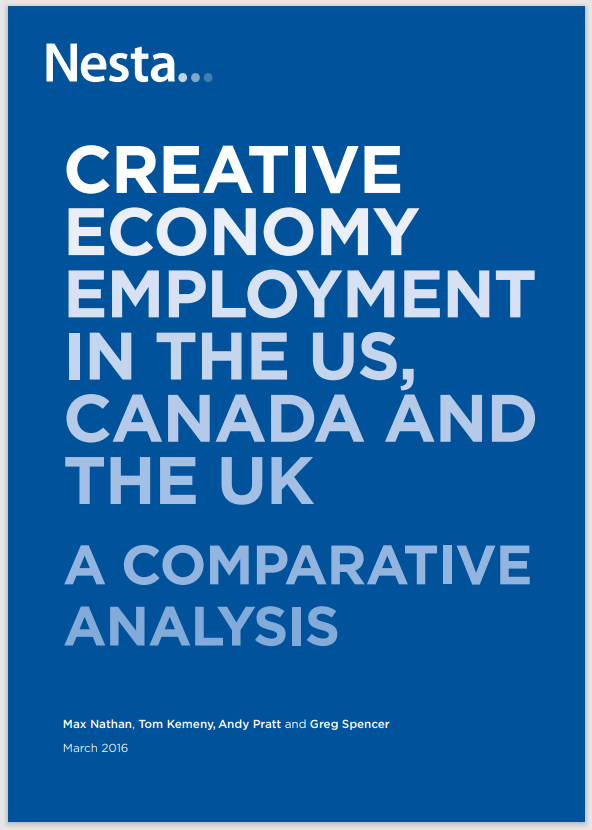
Creative Economy Employment in the US, Canada and the UK
This report measured employment in the creative economies of the US, Canada and the UK. It provided consistent statistics on the US and Canadian creative economies in comparison to the UK. Employment figures for creative industry groups are also provided.
Publication date: 23 March 2016
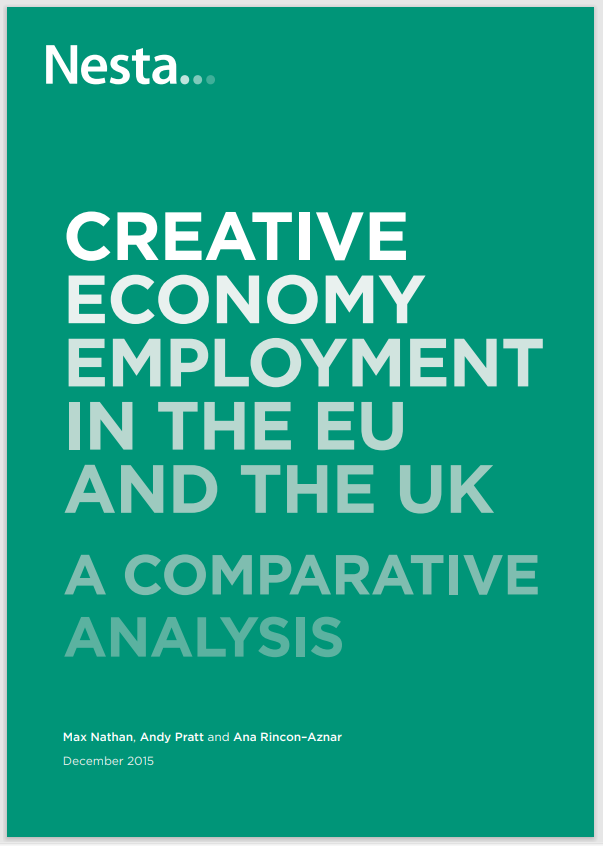
Creative economy employment in the EU and UK: A comparative analysis.
This report compared the size and growth of the EU’s creative industries on a consistent basis. It also provided consistent statistics for the creative economies (employment in creative industries and in creative occupations outside of these) for 20 of the member states. Six countries are examined in detail (France, Germany, Netherlands, Poland and Sweden, and the UK).
Publication date: 07 December 2015
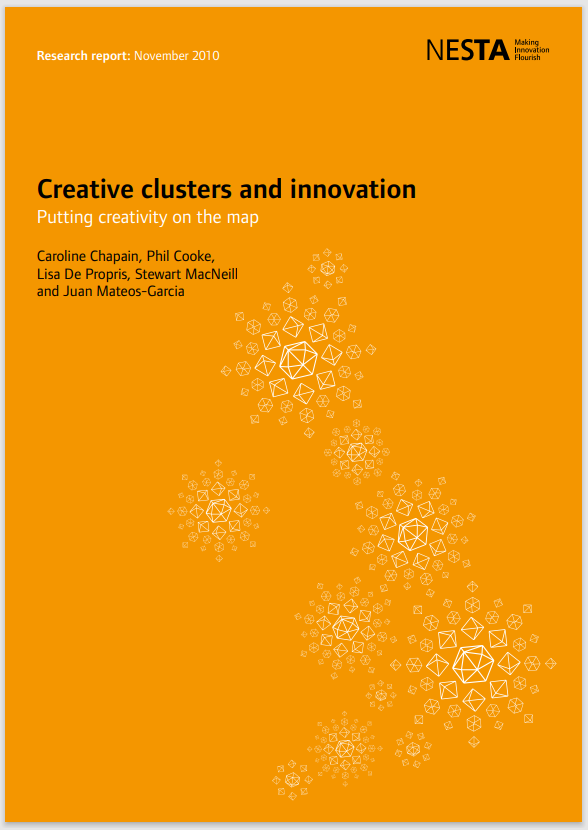
Creative Clusters and Innovation
This report attempted to map the UK’s creative clusters and makes a case for a new approach to local economic policy. The study adopted the concept of creative clusters as a starting point to examine the role that creative industries play in local and regional innovation systems.
Publication date: 01 November 2010

The Geography of creativity
This report mapped the presence of creative firms across Britain as a first step towards establishing their impact on regional innovation.
Although London has a predominant position in most creative sectors, and especially in the most intrinsically creative stages of the value chain, there are other places across Great Britain with strong creative presence. The report used economic geography techniques to address how spatial dimension affects creative industries role in innovation in growth.
Publication date: July 2016
Creative Skills
According to Nesta’s Dynamic Mapping approach to classifying the creative industries, the defining feature of the creative industries is the high proportion of their workforce that are employed in creative occupations. So, creative skills development was a longstanding priority in Nesta’s research.
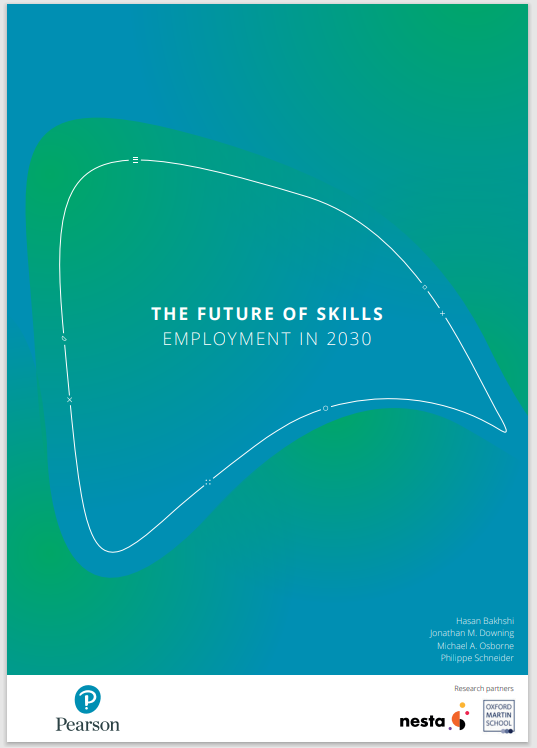
The Future of Skills: Employment in 2030.
This report mapped out how employment was likely to change in the future – including the implications for skills – and anticipates a number of new occupations. The study challenged the false alarmism that contributes to a culture of risk aversion and holds back technology adoption, innovation, and growth; this matters particularly to countries like the US and the UK, which already face structural productivity problems.
Publication date: 27 September 2017
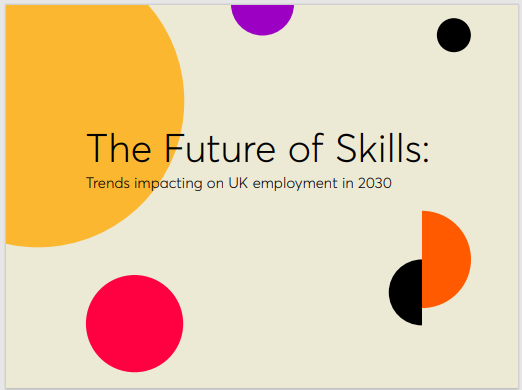
The Future of Skills: Trends impacting on US and UK employment in 2030.
The drivers of change shaping the future of US and UK employment and the need for different skills. This slide deck sets out seven major trends that will shape the future of the UK labour market and skills needs by 2030.
Publication date: 15 August 2017
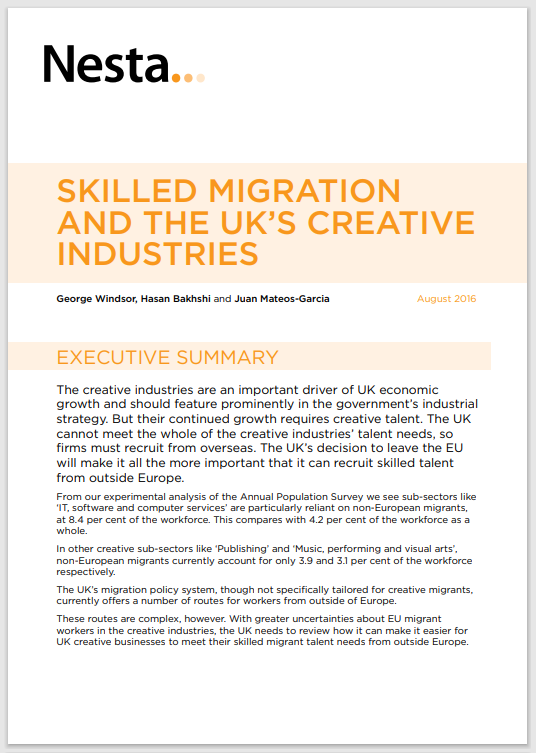
Skilled migration and the UK’s creative industries
This report argued that to support the growth of the creative industries, we need to ensure that the UK is able to access talent from outside of Europe.
Publication date: August 2016
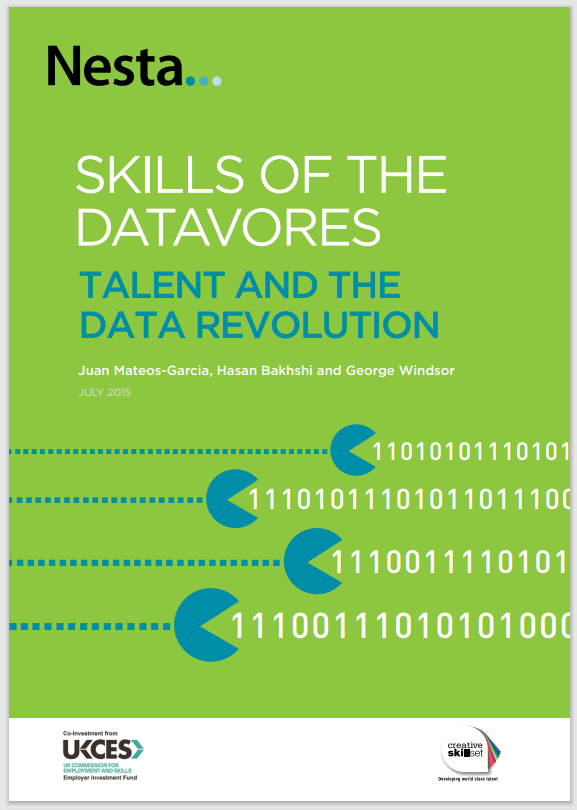
Skills of the Datavores: Talent and the data revolution
UK businesses need the right analytic skills to thrive in the big data era. This report identified what these skills are, and the situation in the labour market for data analysts. This report drew on data from a business survey to identify what these skills are, and the situation in the labour market for data analysts in the UK. Its ultimate goal was to improve our understanding of the value of analytics skills, and inform education and skills policy to ensure UK businesses have access to the talent they need to thrive in the big data era.
Publication date: 10 July 2015
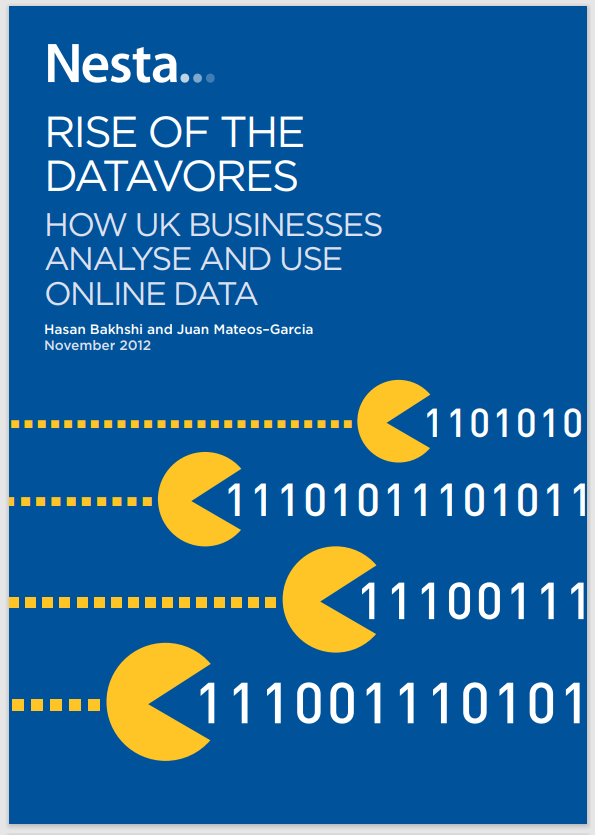
Rise of the datavores: how UK businesses can benefit from their data
This report looked at how only a small minority of UK businesses use data analysis despite the significant benefit it brings. A business survey by Nesta showed how a small but significant group of UK companies – the Datavores – are making sophisticated use of data to drive business decisions. This publication illustrated both the opportunities and challenges that online data presents for UK businesses.
Publication date: 04 November 2012
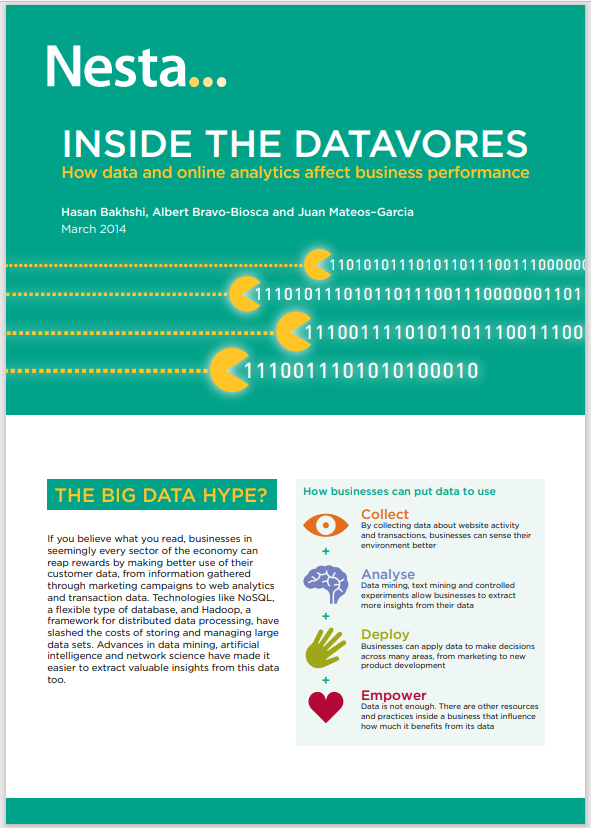
Briefing: Inside the Datavores
This briefing paper describes the background, data, method and findings of an analysis of the link between data activity and business performance. The findings were based on an econometric analysis of the link between data activity and business performance in a sample of 500 UK companies that are active online.
Publication date: 07 March 2014
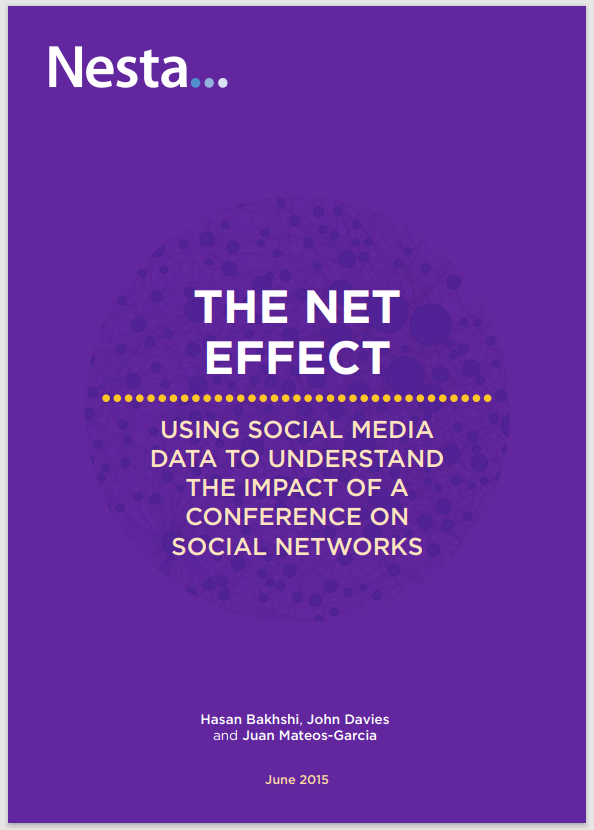
The Net Effect: Using social media data to understand the impact of a conference on social networks
The research used social media data from Twitter to develop a methodology for understanding the effects of events and conferences. This research develops a methodology for using social media to understand events. The approach was developed using Twitter data from the LeWeb London tech festival. It can potentially used at any large conference/event where there is Twitter use (or other source of social network data). Its widespread adoption would allow a range of different measures of event effects to be obtained and benchmarked against each other.
Publication date: June 2015
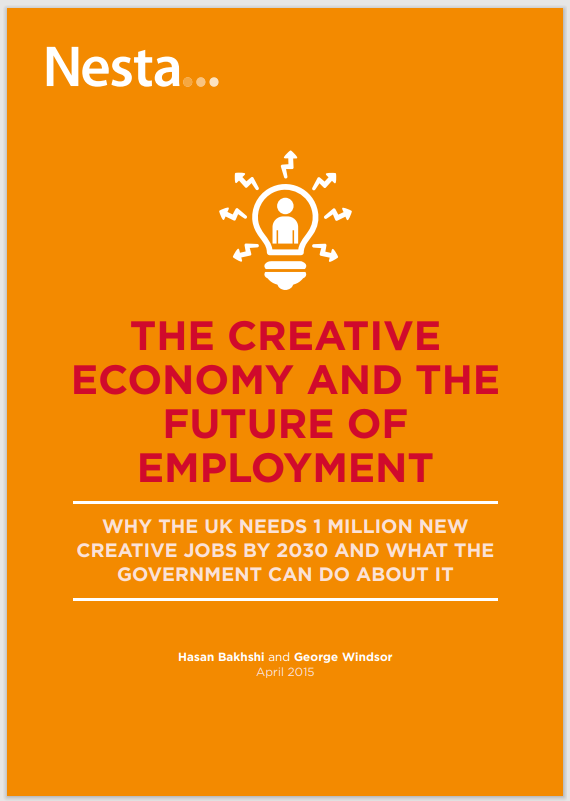
The creative economy and the future of employment
This paper looks at why the UK needs one million new creative jobs by 2030 and offers five sets of policy recommendations for government to achieve this.
Publication date: 21 April 2015
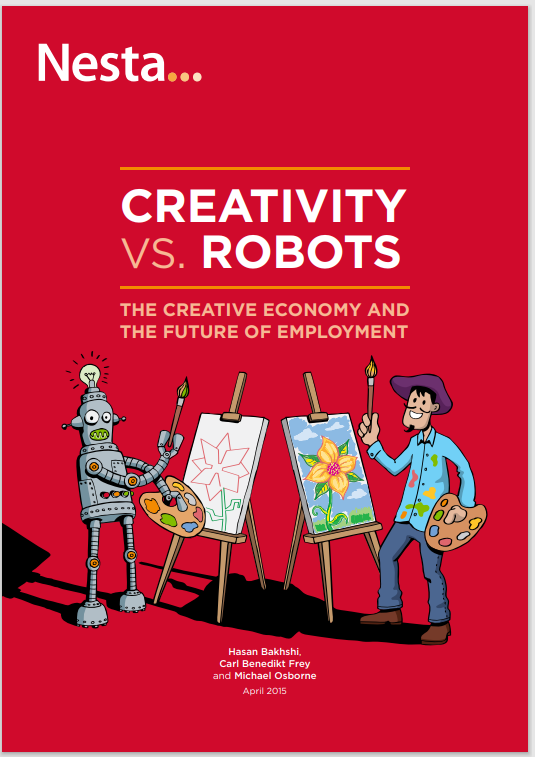
Creativity vs robots
This report explored future automation and creativity in the UK and US workforces and found that creative jobs will be much more resistant to automation than most other jobs.
These findings reflect the fact that machines can most successfully emulate humans when a problem is well specified in advance and when the work task environment is sufficiently simple to enable autonomous control. They will struggle when tasks are highly interpretive, geared at ‘products whose final form is not fully specified in advance’, and when work task environments are complex – a good description of most creative occupations.
Publication date: 17 April 2015
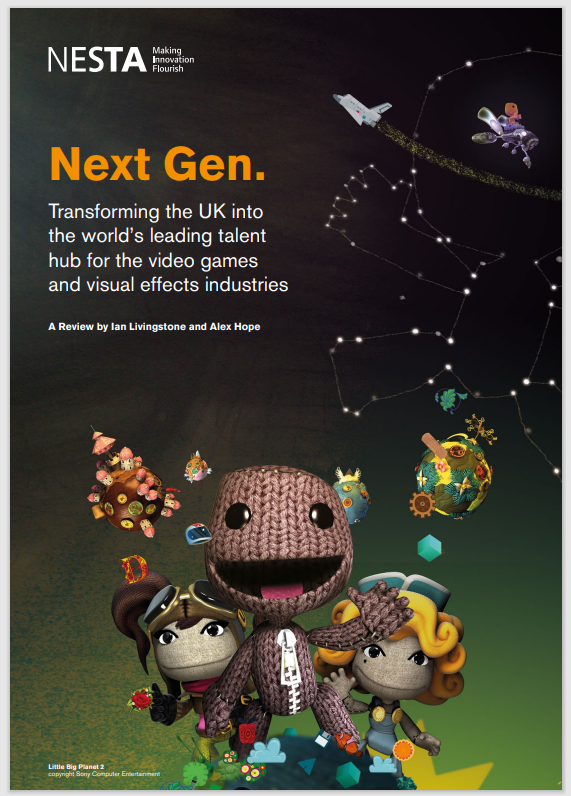
Next Gen.
This landmark report set out how the UK can be transformed into the world’s leading talent hub for video games and visual effects.
Publication date: February 2011
Innovation and R&D Policy
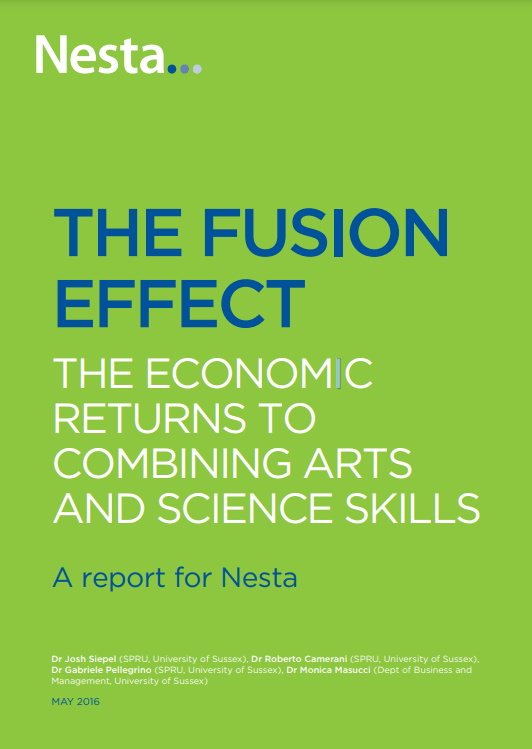
The Fusion Effect: The Economic Returns to Combining Arts and Science Skills
This report explores the performance of businesses with fused skills – those
companies that fuse science and arts skills. It uses official UK data on innovation and firm capability.
Publication date: May 2016

Assessing an experimental approach to industrial policy evaluation: Applying RCT+ to the case of Creative Credits
In this paper the authors assessed the Randomized Controlled Trial plus (RCT+) approach through an evaluation of Creative Credits – a UK business-to-business innovation voucher initiative intended to promote new innovation partnerships between SMEs and creative service providers. The results suggest the potential value of the RCT+ approach to industrial policy evaluation, and the benefits of mixed methods and longitudinal data collection.
Publication date: 18 May 2015
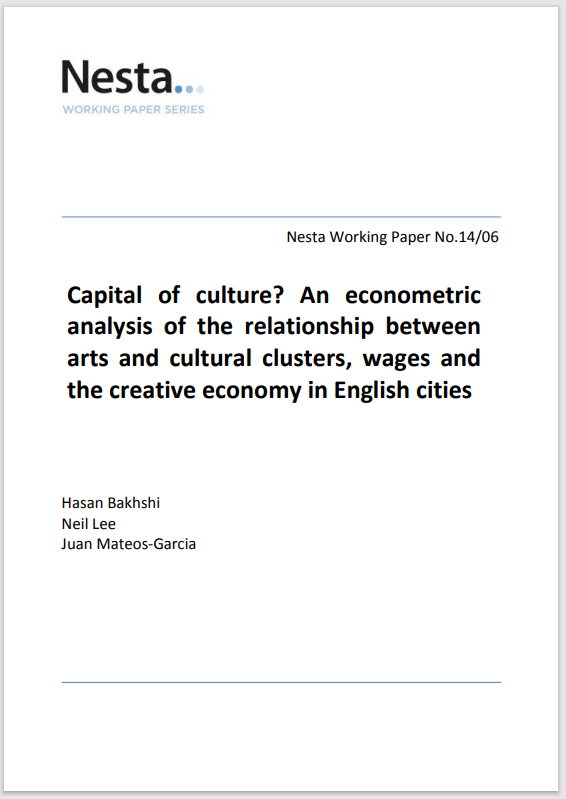
Capital of culture?
An econometric analysis of the relationship between arts and cultural clusters, wages and the creative economy in English cities
In this paper, the authors built an econometric model that explores the impact of cultural clusters on the productivity of English cities using employment, occupational and institutional measures. Their analysis revealed a negative link between cultural clustering and wages, which they interpret as evidence of a compensating differential – skilled workers sacrificing higher salaries to live in places with vibrant cultural scenes.
Publication date: 20 August 2014
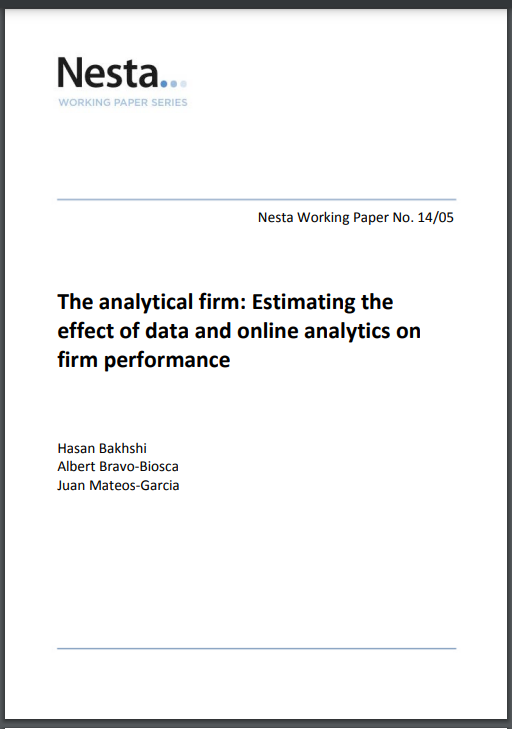
The analytical firm: estimating the effect of data and online analytics on firm performance
This paper used a survey of data activity for 500 UK firms which were commercially active online to quantify the contribution that online data use – that is, the collection, analysis and deployment of online customer data – makes to business productivity.
The authors found that the impact of online data use is stronger for firms with higher levels of employee autonomy, and for firms willing to disrupt their business processes. An implication for managers is that their data investments stand to generate more benefits when they are accompanied by other organisational changes.
Publication date: 20 August 2014
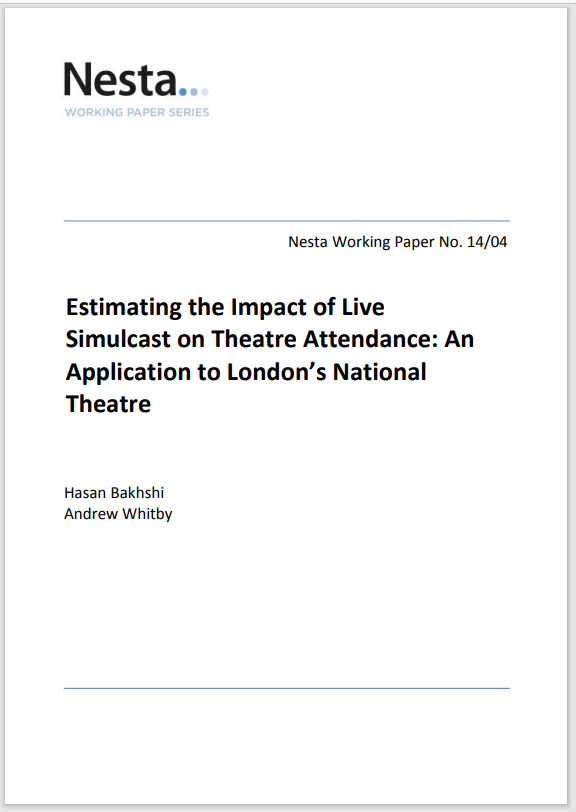
Estimating the Impact of Live Simulcast on Theatre Attendance: An Application to London’s National Theatre
The authors used data for the UK’s early National Theatre (NT) Live broadcasts to conclude that live broadcasts generated greater, not fewer, audiences at the National Theatre. Using a new, extensive dataset of theatre ticket transactions for multiple theatre venues across England, and over a longer time period, they concluded that National Theatre Live is likely to have in addition boosted local theatre attendance in neighbourhoods most exposed to the programme.
Publication date: 24 June 2014
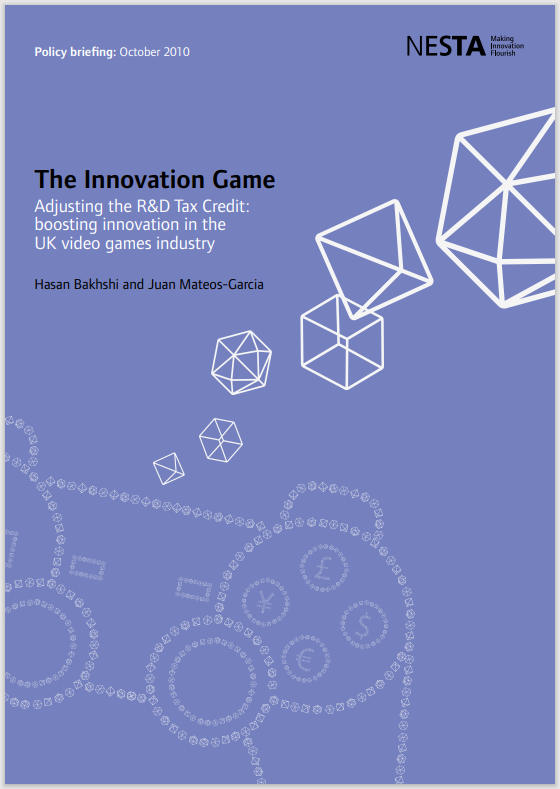
The Innovation Game
The UK is home to a renowned video games development industry and is a place where global publishers have historically wanted to do business. But in recent years making video games in the UK has become less attractive, as overseas territories have introduced generous tax breaks in a bid to retain and bring in investment and talent. This seems to explain the UK’s decline in the global league tables, from 3rd in 2008 to perhaps 6th place in 2010. This report recommended boosting innovation in the UK video games industry by adjusting the R&D tax credit.
Publication date: October 2010
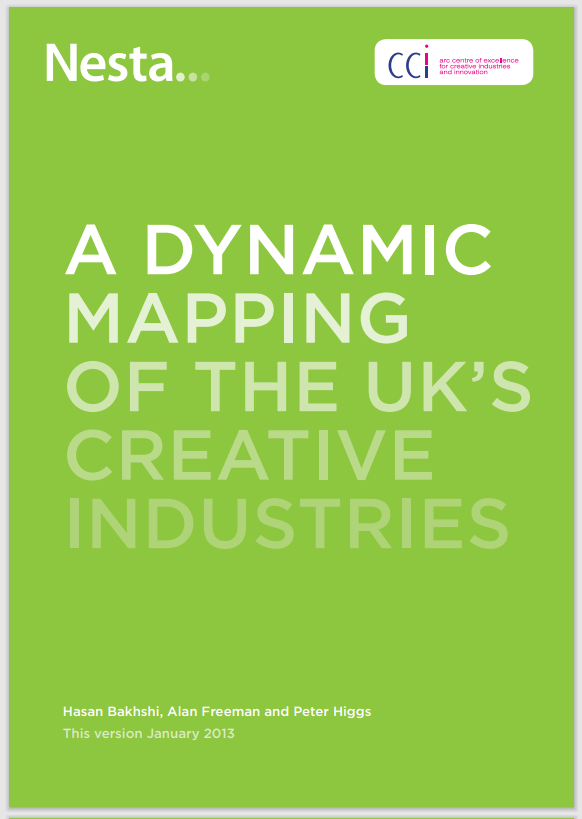
A Dynamic Mapping of the UK’s Creative Industries
This report presented a new way of classifying the UK’s creative industries, and highlighted a number of problems with the current government definition.
The paper argued that, despite its strengths, the UK Department of Culture, Media and Sport (DCMS) definition of the creative industries contains inconsistencies which need to be addressed to make it fully fit for purpose.
Publication date: January 2013

Rise of the Datavores: how UK businesses can benefit from their data
This report looked at how only a small minority of UK businesses use data analysis despite the significant benefit it brings.
Publication date: 04 November 2012
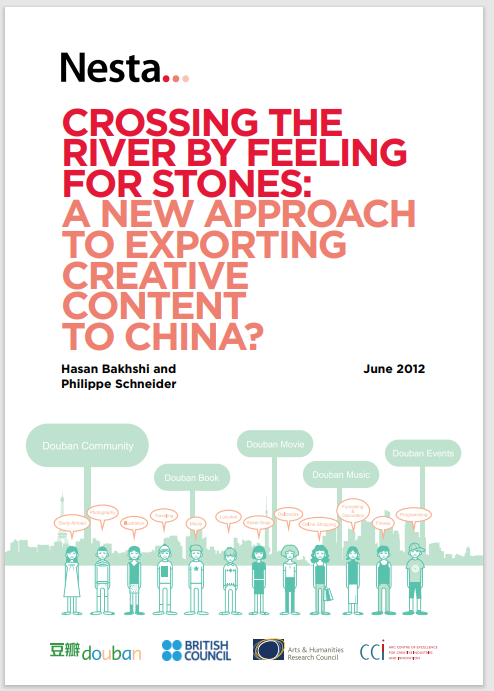
Crossing the River by Feeling for Stones
UK creative industries have yet to take advantage of China’s growth. This paper looked at the barriers to doing business in China, and ways of overcoming them.
This paper examined why creative industries in the UK have yet to fulfil their potential in emerging markets such as China, and looks at the novel role social networks can play in gaining deep insights into consumer demand and behaviour.
Publication date: June 2012
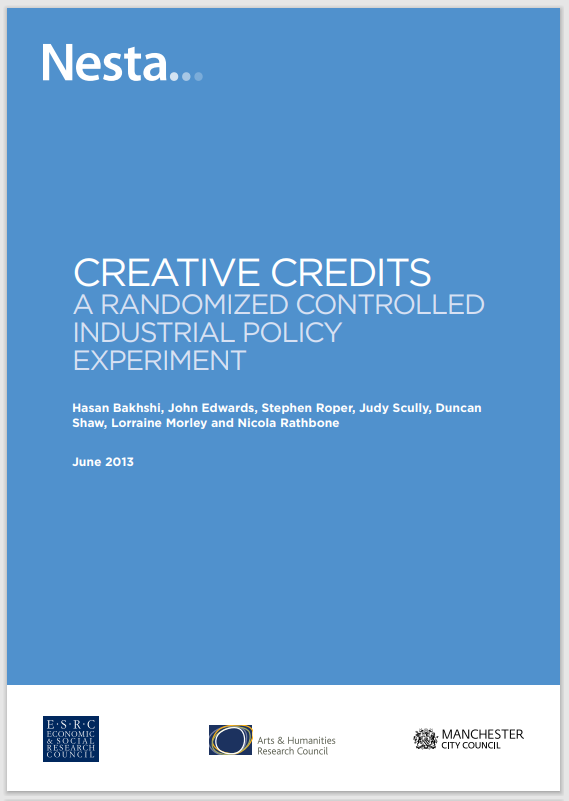
Creative Credits: A randomized controlled industrial policy experiment
This report examines the results of a pilot study, which used a method of evaluation called randomised control trials (RCTs), to see if a popular business support scheme called Creative Credits worked effectively.
Publication date: 17 June 2013
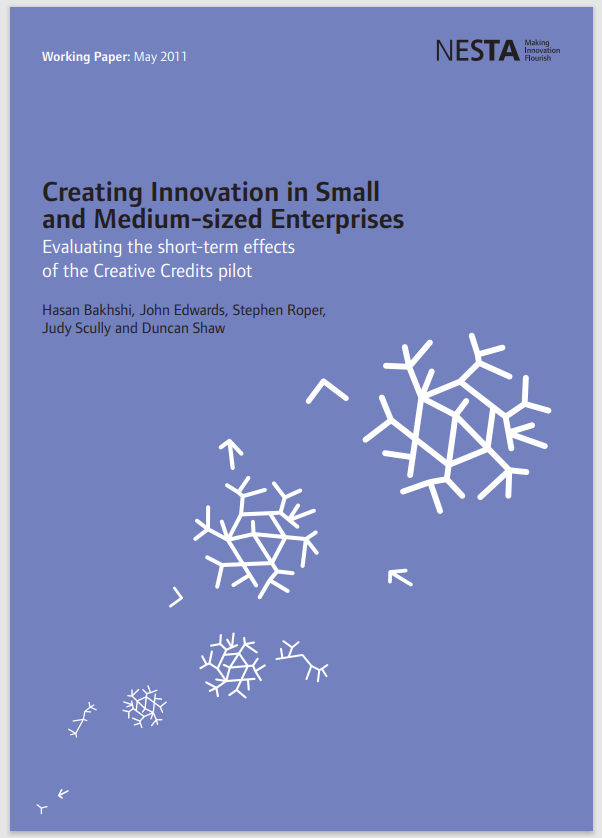
Creating Innovation in Small and Medium-sized Enterprises
This working paper looked at the short-term impact of the Creative Credits pilot scheme which operated in the Manchester region from 2009 to 2010.
Publication date: 04 May 2011
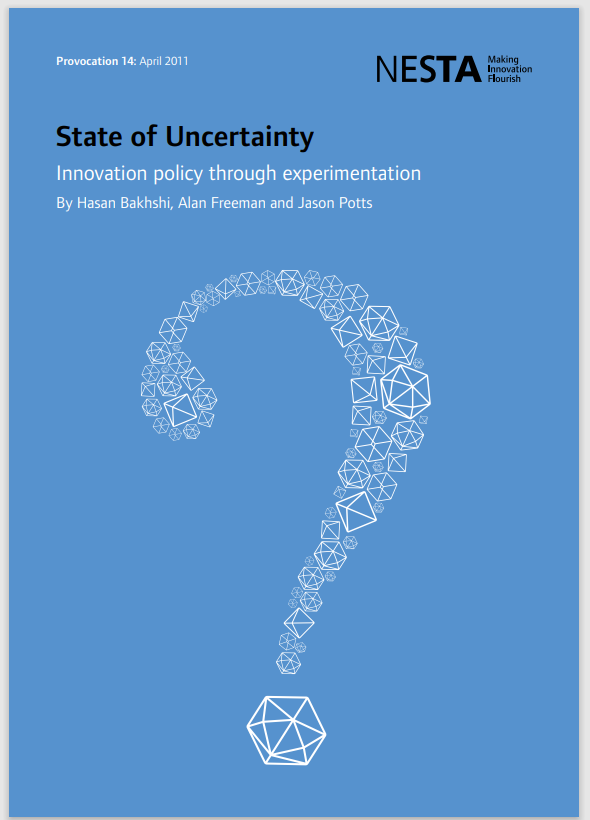
State of Uncertainty
This paper proposed a new model for innovation policy, which supports the generation and exploitation of new ideas.
Innovation policy has desirable effects distinct from those sought by industrial policy: most notably the discovery of knowledge. The authors therefore suggest institutional changes that shift innovation policy towards a more experimental conception of the role of the state in facilitating entrepreneurship, and thereby innovation.
Publication date: 14 April 2011
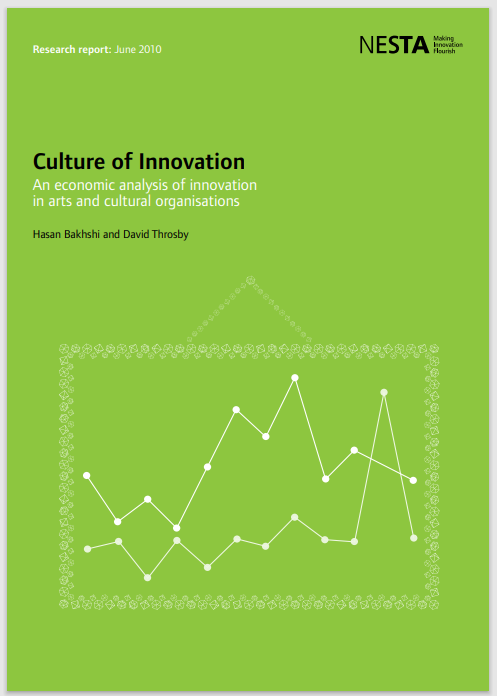
Culture of Innovation
This report tackled the question of how cultural organisations can find ways to innovate in the tightest funding environment they’ve ever faced. It described the rich ways that arts and cultural organisations innovate in audience reach, push out artistic frontiers and create economic and cultural value. Culture of Innovation is the outcome of a novel research-led collaboration between Nesta, the National Theatre and the Tate.
Publication date: 01 June 2010
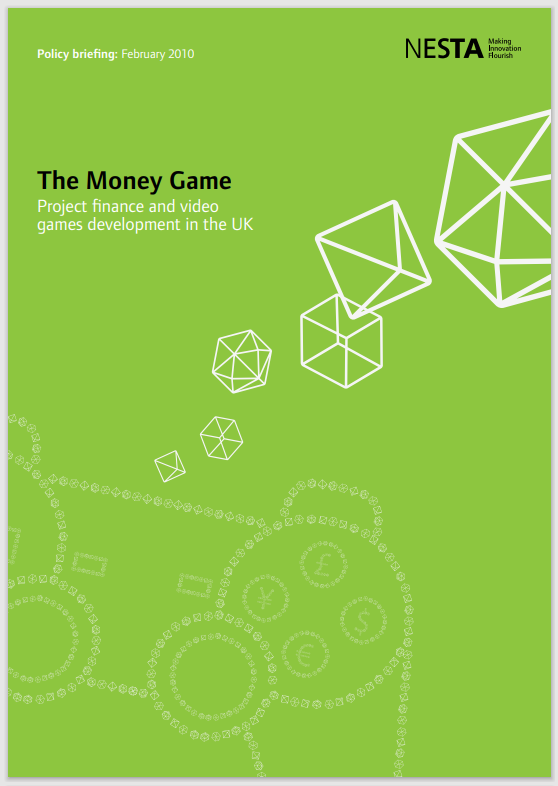
The Money Game: project finance and video games development in the UK
This briefing investigated the value of external project finance to the video games sector, and suggested ways of encouraging it.
Publication date: 01 February 2010
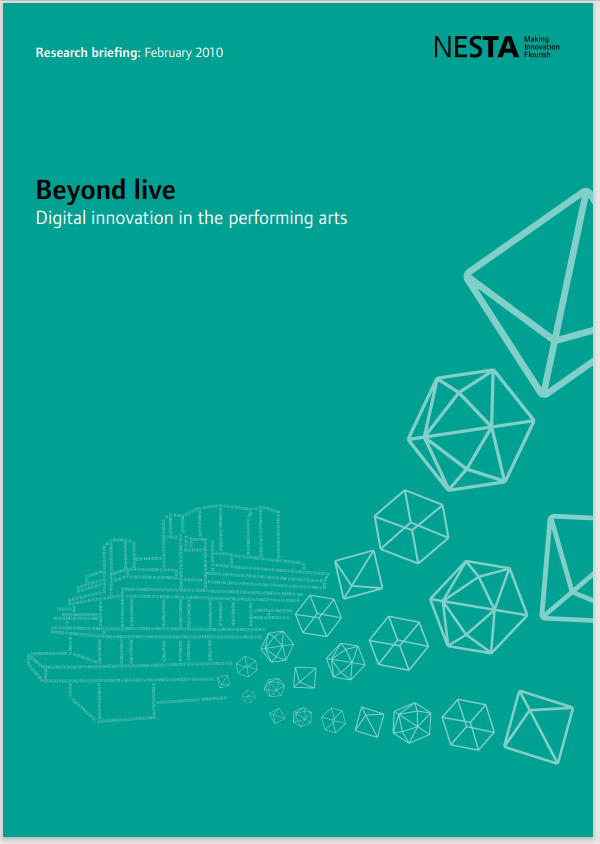
Beyond Live
The researchers conducted an in-depth research study on the two National Theatre Live pilots that were broadcast in 2009 – Phèdre on 25th June and All’s Well That Ends Well on 1st October. The research showed how this innovation has allowed the National to reach new audiences for theatre, not least by drawing on established relationships between cinemas and their patrons all over the country.
Publication date: 01 February 2010

Arts and humanities research and innovation
This paper investigated the role that arts and humanities research plays in the innovation system. This research suggested innovation flourishes when there is a strong knowledge base combined with a culture that embraces novelty and a diversity of ideas. It explores how the Government supports Arts and Humanities research in the UK and its role in the innovation system, as well as work carried out by the Arts and Humanities Research Council.
Publication date: 01 November 2008
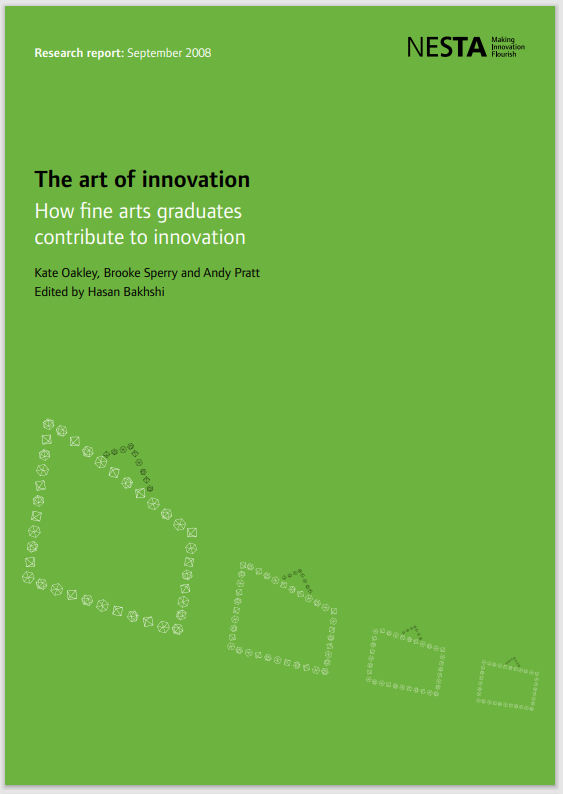
The art of innovation
This report gave insights into how fine arts graduates contribute to innovation in the creative industries and beyond, and what policymakers can do to support their contribution.
Publication date: 01 September 2008

Hidden innovation in the creative industries
This study uses innovation research to examine
the creative industries, reviewing and
extending existing studies, combining a literature
review with some secondary survey analysis,
and presents new case studies of four creative
industries.
Publication date: July 2008
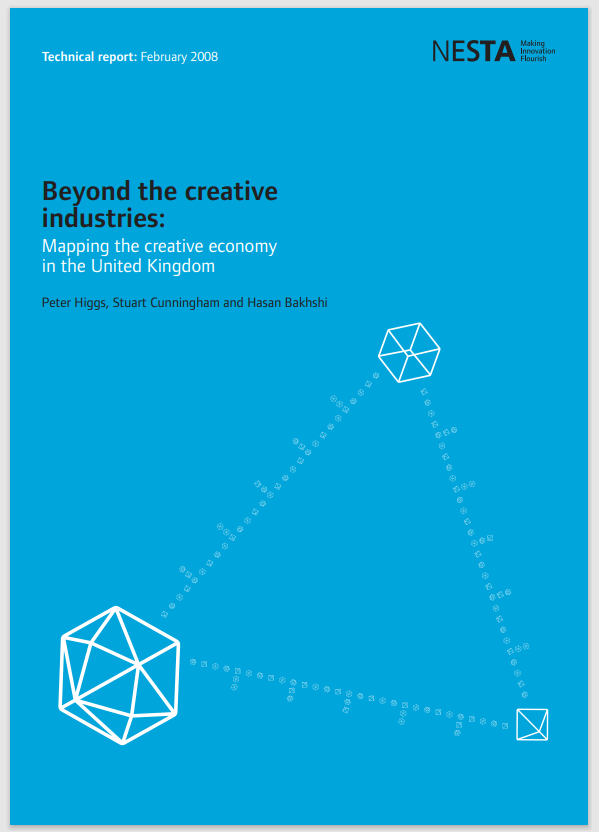
Beyond the creative industries
This report argued for a nationwide strategy to put entrepreneurship at the heart of education for the creative industries. There have been renewed attempts to estimate the true size of the creative economy. The Department for Culture Media and Sport (DCMS) and the Greater London Authority (GLA) both published studies in 2007. This report complemented their work and sought to improve on the available data about the true extent of creative activity within the economy.
Publication date: 01 February 2008
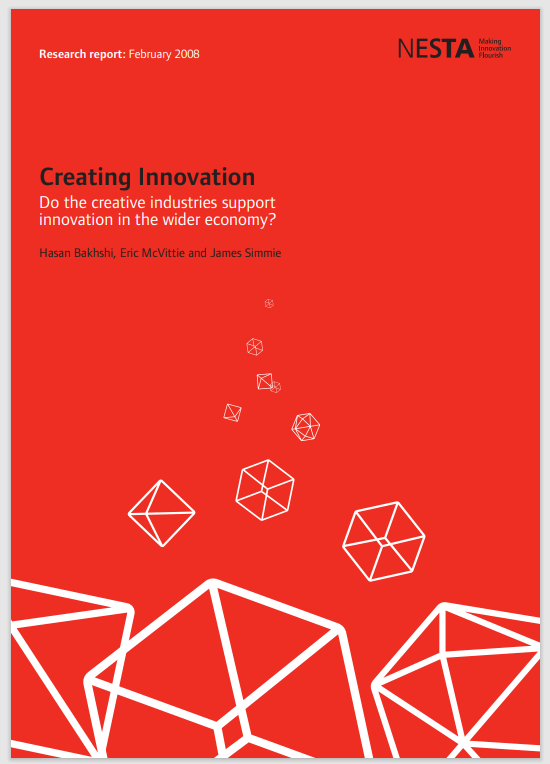
Creating innovation
This report presented the results of research into the role of the creative industries in stimulating and supporting innovation in the UK. The research investigates and quantifies for the first time how artistic and creative activities link into the wider economy.
Publication date: 01 February 2008
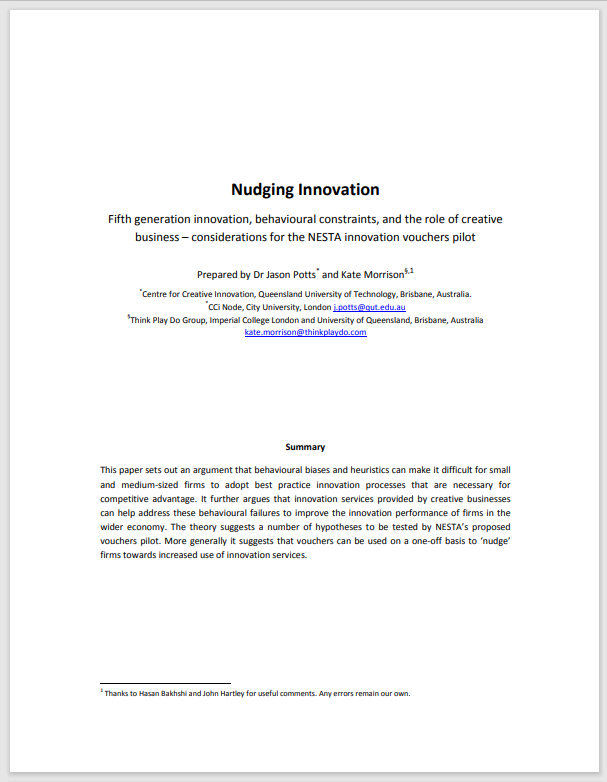
Nudging innovation
This research set out an argument that behavioural biases and habits can make it difficult for small and medium-sized firms to adopt innovation processes that are necessary to become more competitive. The report suggested that innovation services provided by creative businesses can help address habitual behavioural failures to improve the innovation performance of firms in the wider economy.
Publication date: 01 January 2009
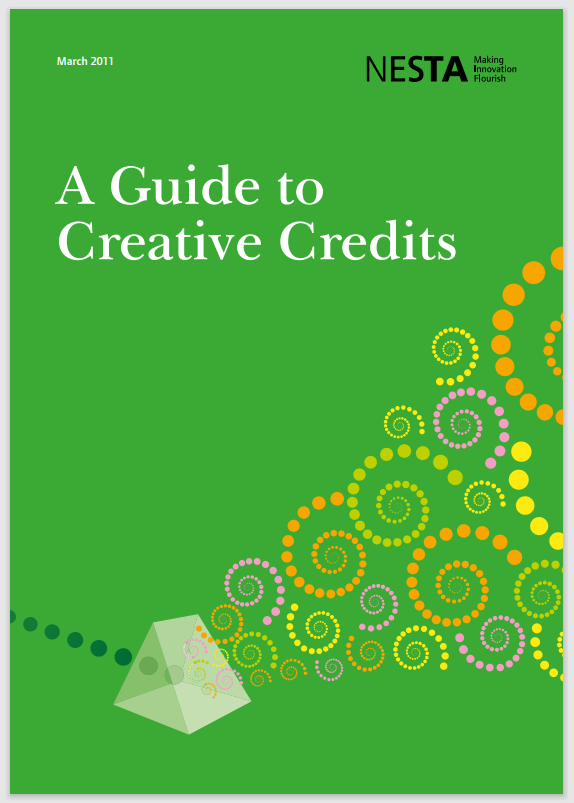
A guide to creative credits
A Guide to Creative Credits described a new model for supporting innovation and growth within small to medium enterprises (SMEs) through knowledge transfer from creative businesses.
Publication date: March 2011
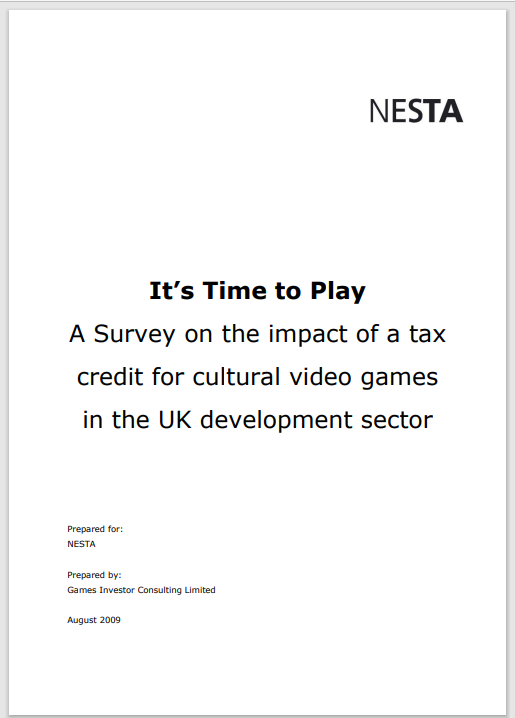
Time to play (by Games Investor Consulting)
Time to Play looked at the potential impact of a tax credit for the British games industry. Nesta commissioned Games Investor Consulting (GIC) to survey 30 leading British video games developers, publishers and sources of funding with the aim of producing robust evidence to inform future government initiatives to support the UK video games sector.
Following the directions set out in Digital Britain, this survey focused on the potential impact of a tax credit for culturally British video games along the lines of those measures already available for the UK film sector and the French video games sector.
Publication date: 01 August 2009
